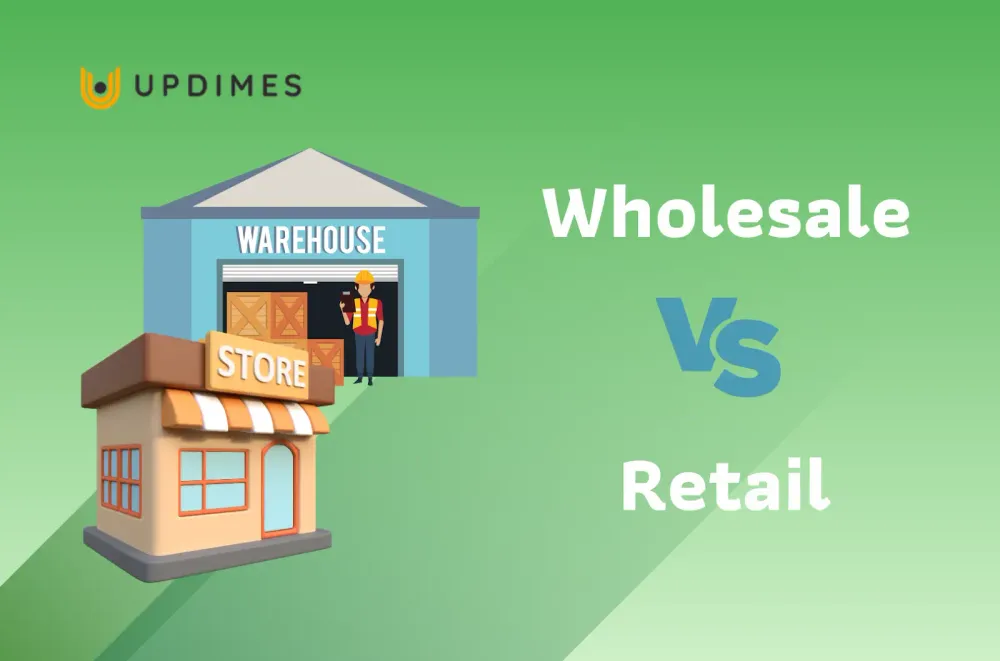Wholesale vs. Retail: What's the Difference?

Wholesale vs retail are two fundamental aspects of the supply chain that drive commerce worldwide. Understanding the disparity between these two concepts is essential for businesses aiming to navigate the complex landscape of buying and selling goods.
While both involve product distribution, they operate in distinct realms. Wholesale transactions typically involve large quantities of goods sold to retailers, businesses, or other wholesalers, whereas retail transactions occur when products are sold directly to consumers in smaller quantities.
Delving deeper into the disparities between wholesale and retail unveils the intricacies that shape the modern marketplace.
Overview of Wholesale vs. Retail
What is wholesale? How does it work?
Wholesale involves the sale of goods in large quantities to retailers, businesses, or other wholesalers for resale purposes. Wholesalers procure products from manufacturers at discounted rates, then sell them in bulk to retailers, who sell to consumers at retail prices. Wholesale operations require establishing relationships with suppliers, managing inventory, and efficient distribution channels.
Wholesalers often offer additional services like packaging and customization. Essentially, wholesale acts as a vital intermediary in the supply chain, facilitating the flow of goods from production to consumption by connecting producers with retailers and ensuring the availability of products in the marketplace.
What is retail? How does it work?
Otherwise, retail involves selling goods or services directly to consumers in smaller quantities for personal use or consumption. Retailers acquire products from wholesalers or manufacturers and sell them to individual customers through physical stores, online platforms, or other channels.
Retail operations encompass various activities such as merchandising, pricing, marketing, and customer service. Retailers aim to create convenient and attractive shopping experiences to attract consumers and drive sales. Ultimately, retail is the final stage in the supply chain, where products reach the end-users, fulfilling their needs and preferences in the marketplace.
The Key Differences Between Retail and Wholesale
Wholesale and retail stand as two distinct pillars shaping the supply chain and consumer experience.
#1. Wholesale vs. retail target audience
Wholesale:
Wholesalers cater primarily to businesses, retailers, and other wholesalers rather than individual consumers. Their target audience comprises entities looking to purchase goods in bulk for resale or further distribution. These buyers often include retailers stocking their shelves, manufacturers sourcing raw materials, or businesses acquiring products for internal use or incorporation into their offerings.
Retail:
In contrast, retailers focus directly on individual consumers as their target audience. They operate storefronts, online platforms, or other channels where products are sold in smaller quantities for personal consumption. Retailers aim to meet individual shoppers' diverse needs and preferences, offering a curated selection of goods and services to fulfill their demands.
#2. Wholesale vs. retail pricing models
Wholesale:
Wholesale pricing models typically involve discounted rates for bulk purchases. Wholesalers negotiate prices with manufacturers or producers to acquire goods at lower costs, enabling them to offer competitive pricing to their clients. The discounted pricing structure reflects the economies of scale achieved through large-volume transactions, allowing wholesalers to generate profit margins by selling at a markup to retailers.
Retail:
Retail pricing revolves around setting prices that appeal to individual consumers while covering operating expenses and generating profits. Retailers often employ pricing strategies such as markup pricing, where the retail price is set above the wholesale cost to account for expenses and desired profit margins. Additionally, retailers may utilize promotional pricing, discounts, and sales to attract customers and drive sales.
#3. Wholesale vs. retail inventory size
Wholesale:
Wholesalers typically maintain extensive inventories to meet the demands of their business clients. Their warehouses or distribution centers house large quantities of diverse products from multiple suppliers. Maintaining substantial inventory levels ensures wholesalers can fulfill orders promptly and efficiently, facilitating the smooth flow of goods through the supply chain.
Retail:
Retailers manage inventories tailored to the preferences and purchasing behaviors of individual consumers. Their inventory varies based on store size, product assortment, and sales forecasts. Retailers strive to balance stocking sufficient quantities to meet customer demand and avoiding excess inventory that could lead to storage costs and markdowns.
#4. Wholesale vs. retail customer experience
Wholesale:
The customer experience in wholesale transactions primarily focuses on efficiency, reliability, and meeting the specific needs of business clients. Wholesalers prioritize seamless order fulfillment, timely delivery, and responsive customer service to build trust and loyalty with their clients. While personalized interactions may occur, the emphasis is often on streamlining processes to accommodate the volume and frequency of transactions.
Retail:
Retailers prioritize delivering exceptional customer experiences that resonate with individual shoppers. From personalized service and tailored recommendations to engaging storefront displays and hassle-free returns, retailers seek to create memorable interactions that foster loyalty and drive repeat business. The retail customer experience encompasses convenience, satisfaction, and emotional connection, influencing purchasing decisions and brand perception.
#5. Wholesale vs. retail operation costs
Wholesale:
Wholesalers incur operational costs associated with warehousing, inventory management, transportation, and overhead expenses. While wholesalers may benefit from economies of scale and lower per-unit costs due to bulk purchasing, they must invest in infrastructure and logistics to support their distribution network and fulfill orders efficiently.
Retail:
Retailers face operation costs related to storefront or online platform maintenance, staffing, marketing, inventory management, and customer service. These costs vary depending on store location, size, industry, and sales volume. To remain competitive in the marketplace, retailers strive to optimize operational efficiency while delivering value and quality service to customers.
#6. Wholesale vs. retail location
Wholesale:
Wholesalers often locate their facilities in areas with convenient access to transportation networks, such as highways, ports, or distribution hubs. The focus is on logistical efficiency and proximity to suppliers and clients rather than consumer foot traffic. Wholesale operations may encompass regional or national distribution centers strategically positioned to serve a broad client base.
Retail:
Retailers prioritize locations with high visibility, accessibility, and consumer traffic to maximize sales and brand exposure. Whether in shopping malls, commercial districts, or online platforms, retail locations are strategically chosen to attract target customers and drive foot traffic. Factors such as demographics, competition, and market trends influence retailers' decisions regarding store locations and expansion strategies.
#7. Wholesale vs. retail access
Wholesale:
Access to wholesale goods is typically restricted to businesses, retailers, or authorized resellers with established accounts or purchasing agreements. Producers may require wholesale: ts to meet certain criteria, such as minimum order quantities, credit checks, or resale certificates, to access their products and services. This approach helps wholesalers control their distribution channels and protect their business interests.
Retail:
Retail accessibility extends. So, any individual can participate in retail shopping.
The distinctions between wholesale and retail encompass diverse facets of the supply chain and consumer engagement. While wholesale focuses on bulk transactions, business clients, and operational efficiency, retail revolves around individual consumers, personalized experiences, and strategic storefront locations.
What are The Benefits and Key Considerations of Wholesale vs. Retail?
Wholesale and retail each offer distinct benefits and considerations that businesses must weigh when deciding on their distribution and sales strategies.
Competition
In wholesale, businesses often face competition primarily from other wholesalers or suppliers. The competition is focused on pricing, product quality, and service reliability.
In contrast, retail competition is more diverse, encompassing other retailers within the same sector, online competitors, local businesses, and global brands. Retailers must differentiate themselves through unique offerings, customer experience, and marketing strategies to stand out in a crowded marketplace.
Customer experience
Wholesale transactions typically prioritize efficiency and reliability over personalized customer experiences. Wholesalers focus on meeting the needs of business clients through streamlined ordering processes, timely delivery, and responsive customer service.
In retail, customer experience is paramount, with retailers striving to create engaging, seamless, and memorable interactions that drive customer satisfaction, loyalty, and repeat business.
Profit margin
Wholesale operations often operate on lower profit margins due to the competitive nature of the industry and the volume-driven pricing model. However, wholesalers can achieve economies of scale by selling large quantities of goods, increasing revenue despite lower margins.
Conversely, retailers have the potential for higher profit margins per unit sold. Still, they must balance pricing strategies with operational expenses, competition, and consumer demand to maximize profitability.
Operational expenses
Wholesalers typically have lower operational expenses than retailers, focusing on warehousing, inventory management, and distribution rather than storefronts, marketing, and customer-facing personnel. However, wholesalers still incur costs related to logistics, storage, and maintaining efficient supply chains.
Retailers face higher operational expenses due to rent, utilities, staffing, marketing, and other costs associated with maintaining storefronts and providing customer service.
Inventory management
Wholesalers manage large inventories of diverse products to meet the demands of business clients and maintain efficient supply chains. Inventory turnover and management are critical for wholesalers to minimize carrying costs and ensure timely order fulfillment.
Retailers must also manage inventory effectively to meet consumer demand, avoid stockouts or excess inventory, and optimize sales and profit margins. Effective inventory management strategies include demand forecasting, replenishment planning, and inventory optimization techniques tailored to the unique needs of wholesale and retail operations.
Who Makes More of a Profit: Wholesalers vs Retailers?
Determining which entity, wholesalers or retailers, generates greater profits takes a lot of work. It hinges on factors such as the costs of goods sold (COGS), sales prices, and business structure.
Wholesalers incur expenses for raw materials, manufacturing, and labor, yet they have the autonomy to set prices and exert some influence on the market.
On the other hand, retailers purchase products at higher COGS than wholesalers but can command higher markups. Despite failing to engage in manufacturing, retailers shoulder expenses for staffing, commercial space, marketing, and more.
In essence, both wholesalers and retailers stand to yield substantial profits by minimizing COGS and maximizing sales prices. Retailers with minimal overhead costs, such as those operating dropshipping ventures, often achieve commendable profit margins.
Unlock The Power of Wholesale and Retail Sales on Shopify.
You can do both wholesale and retail. Many successful businesses today diversify beyond solely wholesale or retail operations. Many firms participate across the entire spectrum of the commerce supply chain.
It's evident that integrating wholesale sales presents a lucrative opportunity for any online retailer. With wholesalers prioritizing volume, efficiency, and robust customer relationships, it is a valuable sales avenue for burgeoning and established eCommerce brands.
Shopify simplifies B2B transactions with features for inventory management, bulk order processing, and customer relationship management. Establish a password-protected wholesale section on your eCommerce platform to cater to other businesses directly.
FAQs of Wholesale vs. Retail
What is the difference between retail and wholesale?
Retail involves selling goods in smaller quantities directly to consumers, while wholesale sells goods in larger quantities to businesses for resale purposes.
Is it cheaper to buy wholesale or retail?
Buying wholesale is typically cheaper per unit than retail. Wholesalers offer discounted rates for bulk purchases, enabling businesses to save money by purchasing goods in larger quantities.
What makes more money, wholesale or retail?
Wholesale versus retail profitability depends on factors such as markup, sales volume, and operational costs. While wholesalers may achieve higher sales volumes, retailers often command higher profit margins per unit sold.
Is Walmart wholesale or retail?
Walmart is a retail giant that offers a wide range of products to individual consumers through its chain of stores and online platform. While Walmart may engage in some wholesale transactions with suppliers, its primary business model revolves around retail sales to consumers.
Wrapping up: Wholesale vs. Retail
Wholesale vs retail are two integral components of the supply chain, each with unique market characteristics and roles. While wholesale transactions cater to businesses and involve bulk sales at discounted rates, retail transactions target individual consumers, with smaller quantities sold at higher prices.
Understanding the distinctions between wholesale and retail is essential for businesses to devise effective distribution strategies, optimize profitability, and navigate the ever-evolving landscape of commerce with clarity and insight.
